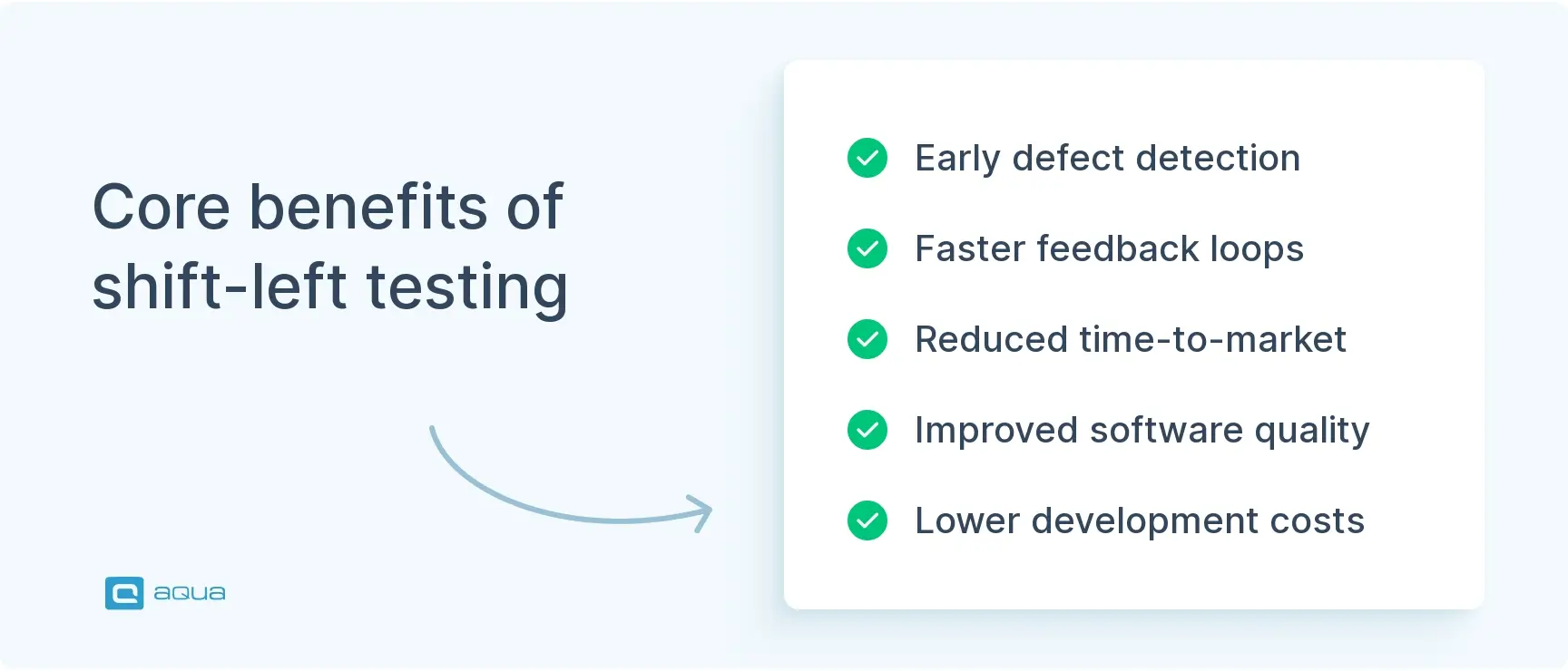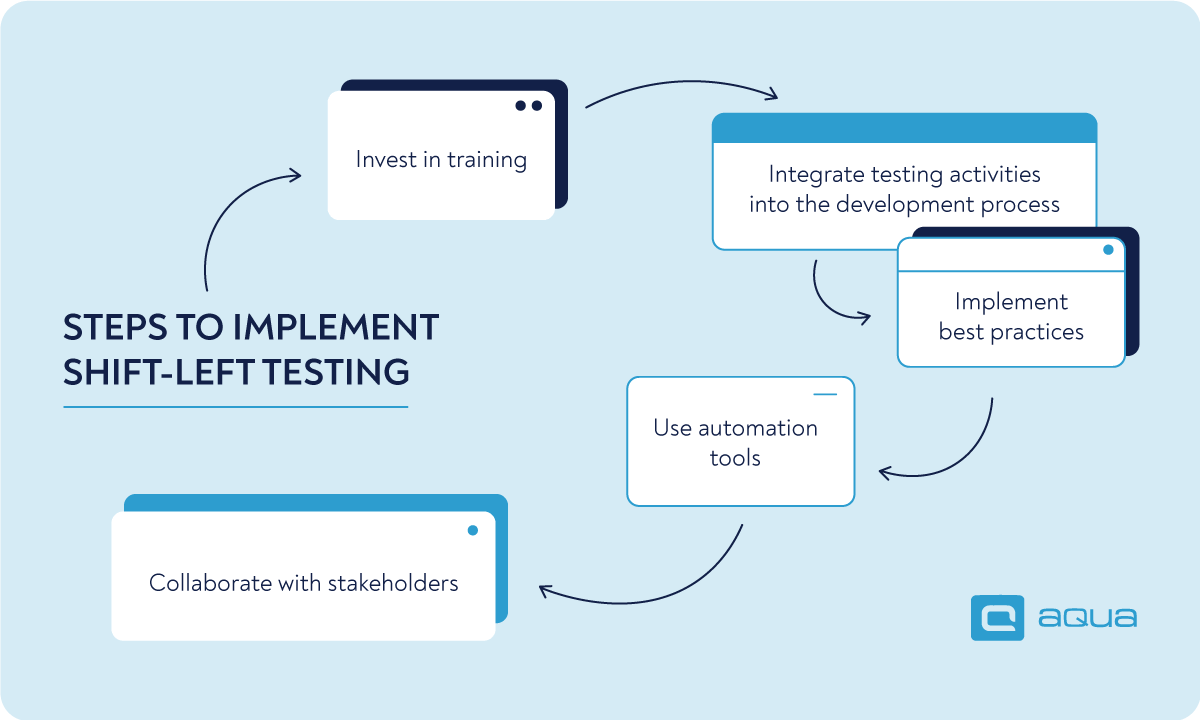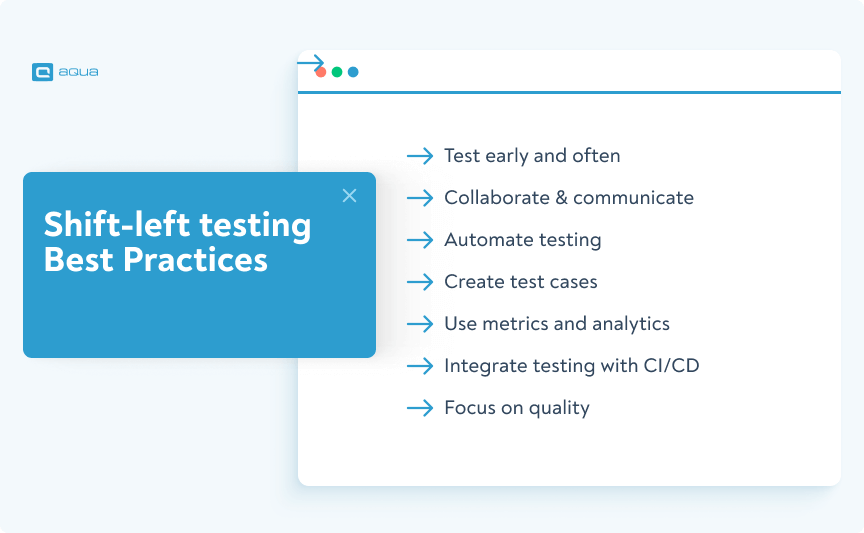What is shift-left testing?
Shift-left testing is an approach that moves testing activities earlier in the software development lifecycle. Unlike traditional testing methods, it involves integrating testing processes with development rather than performing them towards the end. This way, you can identify bugs and defects earlier in the process and reduce the risk of them appearing later in the software development lifecycle.
"Test early and often."
The main goal of shift-left testing is to improve software quality while reducing the time and costs of fixing bugs. It is a significant part of DevOps practices and contributes to a culture of collaboration and continuous improvement.
We’ve discussed DevOps more extensively in our latest video, it could be useful for your learning.
Why is it called a shift to the left?
So why do we call it shift-left testing? In traditional software development models, testing typically occurs towards the end of the development process, often called the “right” side of the development timeline. However, with the rise of Agile and DevOps methodologies, there has been a shift in approach where testing is moved earlier in the development process. Hence, the term “shift to the left.”
This means that you perform testing activities, like unit testing, integration testing, and automated testing, earlier in the development lifecycle, closer to the initial stages of coding and development. Shift-left basic principles aim to identify and address defects and issues earlier in the development process, leading to faster feedback loops, reduced costs, and improved software quality.
The Importance of Shift-Left Testing
So, why do you need shift-left testing in your development process? It’s simple: addressing issues early on minimises risks, reduces costs, and improves overall product quality. With traditional approaches, you often wait until the later stages of development to tackle testing, which can mean costly fixes and delays. Shift-left testing changes that by encouraging early testing, leading to faster feedback and smoother releases.
By identifying and resolving defects earlier, you can make incremental improvements without the pressure of last-minute fixes. It helps you ensure each stage of development is robust. This shift allows you to catch critical issues when they’re faster and cheaper to fix, ultimately keeping project budgets and timelines on track. Plus, with testing integrated from the start, developers and testers collaborate more closely, sharing insights that lead to well-rounded, reliable code.
Shift-left testing also supports better user satisfaction by catching potential issues before they reach production. You’re able to release high-quality software on schedule, without surprises or hidden defects impacting your users.
Elements of Shift-Left Testing
You’re probably thinking shift-left testing is just “test early” – but here’s what actually moves the needle: weaving automation directly into your code commits and getting your devs to poke around with test cases before they even finish coding.
You need to set up feedback loops that ping your team within minutes, not hours. Teams doing this right see bug detection rates nearly double in their first sprint.
Start by having developers run one automated test locally before any commit. Simple, but it catches roughly 40% more issues upfront than traditional approaches.
The surprising part – collaboration beats automation every time. Your best shift-left results come when testers and developers actually talk through edge cases together, not from fancy CI/CD pipelines alone.
Early Testing
Early testing means conducting tests as soon as the code is written. It covers:
- Unit tests
- Integration tests
- Basic functionality checks right from the beginning.
This early intervention identifies issues before they escalate. As a result, you catch potential flaws that might otherwise slip through to later stages, where they’re costlier to fix.
For example, in large projects, small defect detection in the code’s foundation can snowball into multiple downstream errors, making it essential to find and fix issues early.
Google, for instance, has adopted early testing to support its rapid product releases, catching minor issues in foundational code that could impact performance or security later. This reduces rework and allows developers to maintain momentum by focusing on building robust features rather than firefighting bugs.
Automation
Every code push needs that immediate feedback loop, and manual testing simply can’t keep up.
Here’s what’s working: developers who embrace writing integration tests alongside their usual unit tests are catching issues nearly 60% faster. Throw in contract testing tools like Pact, and you’re validating both your code logic AND business requirements before they hit production.
Start with one integration test per feature this sprint. Don’t overthink it, just pick your most critical user flow and automate that pathway.
The teams seeing real success aren’t just testing functionality; they’re validating that what they built actually matches what stakeholders asked for. BDD frameworks make this surprisingly straightforward, turning requirements into executable tests.
Your goal? Fast, reliable feedback on every commit. When automation handles the heavy lifting, you’ll spot problems while they’re still cheap to fix.
Automated tools like Selenium and JUnit allow you to test complex scenarios in seconds. They provide early warnings of issues that would otherwise emerge in production. This enhances reliability and keeps development cycles efficient. That is why automation has become indispensable in today’s fast-paced software development.
Collaborative Approach
Shift-left testing thrives in a collaborative setup, where developers, testers, and stakeholders work together from the outset, sharing responsibility for quality. An integrated teamwork brings diverse perspectives, allowing potential issues to be identified sooner. This way, you can create a shared sense of ownership in the product’s success.
For example, Amazon’s development teams implement a collaborative “you build it, you run it” approach. This is where developers are involved in testing and monitoring their code even after it’s deployed.
This accountability enables strong quality standards, as developers understand the importance of delivering code that meets performance and reliability expectations. When everyone is engaged in early testing, here is the benefits you get:
- Feedback loops shorten
- Communication improves
- Code quality gets an early boost
So it should be no surprise to understand how important collaboration is in this case.
CI/CD
Continuous Integration and Continuous Deployment (CI/CD) are also integral to shift-left testing. In CI/CD, you automate the integration of code changes and their deployment, supporting rapid testing and feedback at every stage of development. When CI/CD is in place, every code commit triggers a series of automated tests, ensuring the new code integrates seamlessly without introducing bugs.
Netflix is a prime example of that. Its “Simian Army” automates testing and resilience checks across its infrastructure. This lets Netflix deploy updates frequently and with confidence. Additionally, it minimises downtime and ensures a seamless experience for users. Including CI/CD into shift-left testing practices allows for safe, regular releases and a robust foundation for application testing as they grow.
To implement all these principles effectively, a Test Management System (TMS) is essential. It provides a structured approach to manage, execute, and monitor tests from the earliest development stages. With a TMS, you can:
- Collaborate seamlessly
- Automate processes
- Maintain traceability
This way you ensure every test contributes to identifying and resolving issues before they escalate. And there is a perfect solution designed for all your shift-left testing needs and principles.
aqua cloud’s AI-powered test case creation enables you to set up and execute tests in seconds, aligning seamlessly with shift-left testing by providing built-in optimisations at every step. Also, its centralised repository ensures every team member has access to up-to-date testing assets, helping with smooth collaboration from day one. 100% traceability helps you link test cases directly to requirements, supporting comprehensive coverage and fast defect detection. Plus, integrations with CI/CD tools like Selenium or Ranorex, alongside Jira and Azure DevOps help you automate feedback on each code commit, keeping the entire process agile and efficient.
Leverage 100% AI-powered TMS to empower your shift-left testing strategy
“Shift left to me is more QA and Dev working together on the ticket… Once the Dev is done (or maybe during) and before it is merged they both review the changes and any tests the Dev has done and can give input as to whether the testing was sufficient.”
What are the benefits of shift-left testing?
So why do developers recommend shift-left testing principles? Here are some significant benefits of implementing it:
- Early defect detection and resolution help reduce the costs of fixing issues later in the software development cycle.
- Improved collaboration and communication between development and testing teams with a better understanding of requirements.
- Faster feedback loops allow for more rapid identification and resolution of the bugs.
- Reduced time-to-market for software products as development and testing activities are completed simultaneously.
- Improved software quality due to the early identification of the bugs.
Overall, the list of shift-left testing benefits can be longer, but it depends on how well it is implemented. If done right, it can also improve developer & QA efficiency, productivity, and, ultimately, customer satisfaction.

Challenges of shift-left testing
We’ve talked about the benefits of shift-left testing, but what about the challenges? Moving testing earlier in the development process brings its own set of hurdles you need to be prepared for. Let’s take a look at these challenges and what they mean for your workflow.
- Skill Gaps: Your developers might feel out of their depth writing security or API tests they’ve never tackled before. Here’s what actually works – pair them with QA mentors for a few sprints and throw in some ready-to-use test templates. Teams using this approach see their early-stage bug detection nearly double within months. Start small: pick one developer to champion component testing first, then let that success spread naturally across your team.
- Increased Initial Workload: Testing from the start means more work early on, as developers balance coding and quality checks simultaneously. The dual focus can slow down initial progress, making it feel like a heavy lift. However, as processes smooth out, teams typically find that the upfront effort saves time later by catching issues early.
- Tooling Complexity: Shift-left testing relies on a suite of tools, from QA automation frameworks to CI/CD integrations. Getting these tools set up and learning their ins and outs can be complicated, especially for teams with limited resources. The right tools can make a world of difference, but the initial setup will require patience and expertise.
- Cultural Resistance: For teams used to testing at the end of the development cycle, shift-left testing is a big adjustment. It changes established workflows and may face pushback from team members who are comfortable with the old way. This shift requires leadership, training, and clear communication.
- Maintaining Test Quality: Testing early is only helpful if the tests are high-quality. Poorly written tests can give false positives or miss bugs entirely, leading to a false sense of security. Building effective tests from the start takes discipline and consistency—two things that can be challenging under tight deadlines.
- Collaboration Barriers: Shift-left testing works best with cross-functional collaboration, but not all teams are set up to work closely together. Without good communication and shared goals, early testing efforts can be less effective. Encouraging a culture of openness and regular feedback across roles is essential for making shift-left testing work well.
Overcoming these challenges, or at least being prepared for them, you will feel like you are entirely ready for this huge shift.
Incorporating Security and Performance Testing Early (DevSecOps)
You can’t afford to treat security and performance as afterthoughts anymore. Modern shift-left testing throws security and performance checks right into your earliest development stages – and the results speak for themselves. Teams using Static Application Security Testing (SAST) in pre-commit hooks catch nearly 80% of vulnerabilities before code even hits the main branch. Here’s your starting point: set up automated SAST scans that block commits containing common security flaws like SQL injection or cross-site scripting. Performance testing works the same way – run lightweight load tests during development to spot bottlenecks when they’re cheap to fix, not when your users are complaining. This approach (called DevSecOps) does something interesting: it actually speeds up releases while making them more secure. Why? Because finding a security flaw in development takes 30 minutes to fix; finding it in production can take 30 hours. Your resilient, fast software starts with making security and performance as important as basic functionality from day one.
How to implement shift-left testing?
There are some steps you can follow to implement the shift-left approach effectively:
- Invest in training to ensure both teams have the necessary skills to implement the shift-left methodology.
- Integrate testing activities into the development process to perform them concurrently with the development activities.
- Implement best practices to establish testing standards, develop test cases, and perform code reviews to ensure your testing is complete.
- Mix your automation tools strategically rather than going all-in on one solution. Start by picking tools that actually talk to each other—maybe throw in some test data management alongside your security scanning instead of treating them as separate islands.
- Collaborate with stakeholders, such as business analysts, developers, and testers, to ensure everyone is on the same page and that testing is aligned with business goals.

Shift-left and test automation in DevOps
In DevOps practices, both shift-left and test automation are pivotal strategies to enhance software development processes and ensure high-quality software delivery. We have discussed the aim of the shift left testing strategy in the previous paragraphs. Similarly, test automation complements this approach by providing the means to execute tests rapidly and efficiently. Automated tests, including unit tests and integration tests, enable you to obtain immediate feedback on code changes, allowing you to detect bugs and vulnerabilities earlier.
Furthermore, both shift-left and test automation accelerate feedback loops within the DevOps cycle. By detecting issues early and automating testing processes, you can iterate more quickly and confidently and deliver updates to production. This iterative approach fosters continuous improvement and innovation, driving the evolution of software products in alignment with user needs and market demands.
What are the disciplines of software development to apply the shift-left approach?
To apply the shift-left methodology effectively, there are some practices you should consider, including:
- Coding and code reviews: Code should be written testable, and code reviews must ensure that code is written to the appropriate standards.
- Continuous Integration: You should regularly integrate code changes into the main branch and perform automated builds and tests after each integration.
- Test automation: You should create shift-left automation testing for each function, feature or module of the software to ensure frequent and efficient testing.
- Continuous testing: You should continuously test the code throughout the software development lifecycle to ensure the software is stable at every stage.
- Collaboration and communication: It is crucial to integrate software testing with development effectively and can identify and resolve defects as early as possible to establish strong communication between testing, development, and operations teams.
Applying these principles in your software development process will make sure you implement shift-left testing smoothly and can get the maximum out of it.
What are the best practices for shift-left testing in Agile?
Here are some best practices for implementing shift-left testing in Agile:
- Test early and often: Perform testing as early as possible and regularly test throughout the process.
- Collaborate and communicate: Foster strong, open communication between teams and stakeholders to ensure everyone is on the same page.
- Automate testing: Use automation tools for software testing to reduce the risk of errors, increase efficiency, and enable faster testing.
- Create test cases: Develop detailed test cases that cover all aspects of the software (functional and non-functional), and ensure that you review and update them regularly. Don’t forget about unit testing to spot and solve issues early.
- Use metrics and analytics: Identify metrics and analytics in software testing to identify trends, track progress, and make data-driven decisions.
- Integrate testing with CI/CD: Integrate testing with your CI/CD pipeline to ensure testing is performed at every process stage.
- Focus on quality: Prioritise quality throughout the software development process.
Following these best practices will help you successfully implement shift-left testing in an Agile environment and achieve efficiency and faster time-to-market for your software products.

What will you get after implementing the shift-left strategy?
If you implement the shift-left development efficiently, you will see these positive results:
- Early defect detection: If you test earlier in the software development lifecycle, you can identify and resolve the defects before they become more complex and costly. You are less likely to let defects happen in production, too.
- Faster time-to-market: Identifying and resolving defects earlier in the software development process will ensure you can release your software products quickly and confidently.
- Increased efficiency and productivity: By automating testing activities and integrating testing with development, you can work more efficiently and with greater productivity.
- Increased customer satisfaction: If you can make sure your software has the highest quality, customers will be satisfied with the performance of the product they receive. This is a major factor for increased customer loyalty and retention.
- Reduced costs: Early defect detection and improved software stability will reduce costs associated with fixing defects, delayed releases and lost revenue.
Shift-Left and Shift-Right: Creating a Continuous Quality Feedback Loop
Shift-left is only half the equation. Sure, catching bugs early saves tons of headaches, but what about the stuff you miss? That’s where shift-right comes in clutch. You’re basically watching how users actually behave in production through monitoring, synthetic API testing, and observability tools. The magic happens when you feed those real-world insights back into your dev cycles. Production monitoring reveals patterns that no amount of early testing catches: like that weird edge case that only surfaces when traffic spikes or users do something completely unexpected. Start by setting up one synthetic monitor for your most critical API endpoint; most CI/CD tools can integrate this in under an hour. The feedback loop keeps your quality game strong long after deployment.
Conclusion
Implementing a shift-left approach in your software development process will bring numerous benefits, including early defect detection, faster time-to-market, higher customer satisfaction, reduced costs, and better team morale.
By adopting the best practices examples we provided above, you can successfully implement shift-left testing in an Agile environment and reap the rewards.
If you want to adopt these best practices in your testing, aqua’s testing strategy template is an essential tool for you. With clear requirements for every level of testing, actionable tips to improve your testing processes, and recommendations for choosing the right testing tools, this template is a comprehensive guide to ensuring that your testing is effective and efficient.
For a powerful shift-left testing approach, aqua cloud provides everything you need to catch issues early and streamline collaboration. With AI-powered test data and test case creation in just two clicks, you can quickly build and manage comprehensive tests for each development stage. aqua’s Capture integration allows for 1-click defect recording, enabling instant documentation of bugs with screenshots or video evidence, so issues are clear from the start. Every test asset (manual and automated) is kept in a centralised repository, supporting 100% traceability and test coverage throughout your shift-left journey. Integrated with CI/CD tools, aqua cloud accelerates feedback cycles to ensure seamless functionality as your code evolves. So what is keeping you from shifting your testing efforts to the left with a few clicks?
Streamline your shift-left testing with 100% coverage, traceability, and perfect usage of AI

















